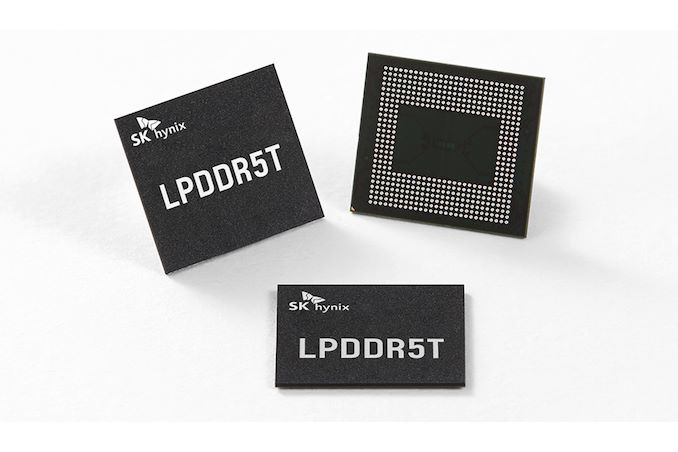SK hynix Ships LPDDR5T: 9600 MT/s Memory for Smartphones
by Anton Shilov on November 14, 2023 3:30 PM EST- Posted in
- Memory
- Smartphones
- SK Hynix
- LPDDR5X
- LPDDR5T

SK hynix had started volume shipments of its LPDDR5T-9600 memory for high-end smartphones, the company announced this week. So far, the company's LPDDR6 'Turbo' memory with a 9600 MT/s data transfer speed has been certified to work with two range-topping mobile application processors from Qualcomm and MediaTek.
SK hynix's LPDDR5T-9600 memory is available in 16 GB packages with a VDD voltage range of 1.01V to 1.12V and a VDDQ of 0.5v. Notably, this VDD range is just slightly over the LPDDR5X specfication (1.00V to 1.1V), which shouldn't be a serious problem, but likely warrants some extra compatibility testing with existing chips.
Smartphone and SoC manufacturers have a great incentive to validate SK hynix's LPDDR5T-9600 and Micron's LPDDR5X-9600 memory as these modules offer a 76.8 GB/s peak bandwidth, up 12.5% from 68.2 GB/s offered by LPDDR5X-8533.
So far, SK Hynix's LPDDR6T-9600 modules have been certified by Qualcomm for its Snapdragon 8 Gen 3 mobile SoC as well as MediaTek for its Dimensity 9300 and some subsequent processors. Meanwhile, SK Hynix confirmed that it had begun shipments of its LPDDR6T-9600 devices to Vivo, which will use it for X100 and X100 Pro mobile application processors.
Following the latest trends, SK hynix mentions that its very fast LPDDR5T-9600 memory will be particularly useful for on-device AI applications. And, of course, faster DRAM is always welcomed for graphics intensive mobile applications, such as games.
"Smartphones are becoming essential devices for implementing on-device AI technology as the AI era kicks into full swing," said Myoungsoo Park, Vice President and Head of DRAM Marketing at SK hynix. "There is a growing demand for high-performing, high-capacity mobile DRAMs in the market. We will continue to lead the premium DRAM market based on our technological leadership in AI memories, while staying in tune with market demands."
Source: SK Hynix










17 Comments
View All Comments
Dante Verizon - Wednesday, November 15, 2023 - link
Exactly. 4-6cores is enough in the limited TDP gaming scenario, the iGPU there is what does the magic.ET - Wednesday, November 15, 2023 - link
This comment shows a misunderstanding of computing power. A 4-core Core i3 12100F beats on average an 8-core Ryzen 7 3700X in games. Four Zen 5c or even Zen 4c cores are likely to beat 8 Zen 2 cores available in consoles.If 4 extra cores take an extra 10 mm2 and raise gaming performance on average by 5% and reduce battery life by 5%, then that's wasted 10 mm2 in my book. Performance will be better served by using that area for a GPU cache or GPU cores, or for reducing the chip's price.
NextGen_Gamer - Wednesday, November 15, 2023 - link
@ ET: I would agree, but I also think this is just another reason why Valve wants to wait and why I agree with that. In another 1-2 years, they could put in 8 Zen 5c cores in a Deck 2, on a TSMC N3 process node. Those 8 cores, on that node, would then take up less space and consume less power than the current 4 Zen 2 cores do now. And Valve would be massively increasing IPC per core, plus doubling the core count. That is what they mean by waiting for huge generational upgrade in perf & perf-per-watt.ET - Wednesday, November 15, 2023 - link
Even if 8 Zen 5c (or whatever) cores on N3 will take less power than 4 Zen 2 cores on N6, 4 cores will still take less power. If 8 cores have very little benefit (and you've offered no argument that they'd be of benefit), then there's no point in having them.I also don't see why Valve will use N3. Valve is trying to keep the device cost reasonably low, and on the processor level this implies a node that's not state-of-the-art and a chip that's as small as possible, while still providing reasonable performance. The Steam Deck APUs do that well, and I don't see a reason for Valve to change this formula.
scineram - Tuesday, November 21, 2023 - link
Since Zen 5 uses N4 but 5c uses N3, I wonder if they would go with 4c instead of porting 5c to N4.name99 - Wednesday, November 15, 2023 - link
Are there errors in the article?We keep jumping between LPDDR5T, LPDDR6, and LPDDR6T.
I *assume* the first is correct, that this is version of LPDDR5 (essentially same voltages, timing structure etc) and that LPDDR6, while it's being worked on and whatever it may bring in terms of new algorithms, is not yet with us?
pinchies - Sunday, November 19, 2023 - link
@Anton Shilov can you please fix the typos?? It's quite confusing.